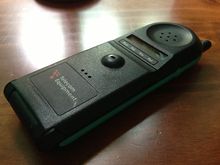Difference between revisions of "CallZone"
| (9 intermediate revisions by 2 users not shown) | |||
| Line 1: | Line 1: | ||
'''CallZone''' was a service offered by | '''CallZone''' was a service offered by PageLink, a subsidiary of SingTel (then known as Telecommunications Equipment) in the 1990s. The service allowed users to make, but not receive, calls using a special handset made by Motorola, in certain designated zones. The technology was similar to CT2-based services already established earlier in the UK, Germany, Hong Kong<ref>[http://www.youtube.com/watch?v=RTKrIp2stG0 1993年 - 和記傳訊 [1993 - Hutchison Paging (commercial)]]</ref>, and elsewhere. | ||
==Description== | ==Description== | ||
[[File:Motorola CallZone 01.JPG|thumb|220px|A CallZone phone, manufactured by Motorola.]] | [[File:Motorola CallZone 01.JPG|thumb|220px|A CallZone phone, manufactured by Motorola.]] | ||
When exactly the CallZone service was introduced is unclear. It is widely stated that the service was introduced sometime in 1991 or 1992. However, an article from July 1994 states that the service was introduced in May 1994.<ref>[http://www.telecompaper.com/news/singapore-telecom-has-success-with-pagerphone--30057#.UjKcBBaxLoA SINGAPORE TELECOM HAS SUCCESS WITH PAGERPHONE]</ref> | |||
Users who subscribed to the service were given a Motorola-made flip-phone, the [http://www.mobilecollectors.net/phone/5029/Motorola+Silverlink+2000+Birdie Silverlink 2000 Birdie] to make calls. These calls could only be made in certain areas with a CALLZONE sign; as of August 2019, some of these signs can still be found around the island.<ref>https://www.reddit.com/r/singapore/comments/ckn9fg/i_just_noticed_this_sign_after_living_in_this/ Reddit SG: Call Zone sign, Aug 2019]</ref>. Handsets were sold at S$350 each in July 1994.<ref>[http://www.telecompaper.com/news/singapore-telecom-has-success-with-pagerphone--30057#.UjKcBBaxLoA SINGAPORE TELECOM HAS SUCCESS WITH PAGERPHONE]</ref> | |||
The network was shut down in October 1998.<ref>[http://www.totaltele.com/view.aspx?C=0&ID=429163 SingTel to Scrap Uncompetitive Callzone]</ref> In a letter to 3,500 subscribers explaining the shutdown, SingTel said that the service was not financially viable because of the emergence of low-cost cellular handsets. Additionally, Motorola had stopped making the handsets.<ref>[http://www.totaltele.com/view.aspx?C=0&ID=429163 SingTel to Scrap Uncompetitive Callzone]</ref> | |||
===Criticism=== | ===Criticism=== | ||
It | It was reported that areas with CALLZONE base stations also had payphones located in the vicinity, which made having a Callzone phone somewhat pointless. | ||
In 1993, The Straits Times also reported that too many users were making calls on their zonephones at the same time, thus jamming the network.<ref>[http://newspapers.nl.sg/Digitised/Issue/straitstimes19931214-1.aspx The Straits Times 14 December 1993]</ref> | |||
==SingTel CallZone== | ==SingTel CallZone== | ||
The CallZone name was resurrected for a service, also offered by SingTel. The service allows SingTel subscribers to make free calls, using a special device connected to a SingNet Broadband modem. | The CallZone name was resurrected for a service, also offered by SingTel. The service allows SingTel subscribers to make free mobile phone calls, using a special device connected to a SingNet Broadband modem. | ||
==References== | ==References== | ||
<references/> | <references/> | ||
Latest revision as of 22:17, 1 August 2019
CallZone was a service offered by PageLink, a subsidiary of SingTel (then known as Telecommunications Equipment) in the 1990s. The service allowed users to make, but not receive, calls using a special handset made by Motorola, in certain designated zones. The technology was similar to CT2-based services already established earlier in the UK, Germany, Hong Kong[1], and elsewhere.
Description[edit]
When exactly the CallZone service was introduced is unclear. It is widely stated that the service was introduced sometime in 1991 or 1992. However, an article from July 1994 states that the service was introduced in May 1994.[2]
Users who subscribed to the service were given a Motorola-made flip-phone, the Silverlink 2000 Birdie to make calls. These calls could only be made in certain areas with a CALLZONE sign; as of August 2019, some of these signs can still be found around the island.[3]. Handsets were sold at S$350 each in July 1994.[4]
The network was shut down in October 1998.[5] In a letter to 3,500 subscribers explaining the shutdown, SingTel said that the service was not financially viable because of the emergence of low-cost cellular handsets. Additionally, Motorola had stopped making the handsets.[6]
Criticism[edit]
It was reported that areas with CALLZONE base stations also had payphones located in the vicinity, which made having a Callzone phone somewhat pointless.
In 1993, The Straits Times also reported that too many users were making calls on their zonephones at the same time, thus jamming the network.[7]
SingTel CallZone[edit]
The CallZone name was resurrected for a service, also offered by SingTel. The service allows SingTel subscribers to make free mobile phone calls, using a special device connected to a SingNet Broadband modem.
References[edit]
- ↑ 1993年 - 和記傳訊 [1993 - Hutchison Paging (commercial)]
- ↑ SINGAPORE TELECOM HAS SUCCESS WITH PAGERPHONE
- ↑ https://www.reddit.com/r/singapore/comments/ckn9fg/i_just_noticed_this_sign_after_living_in_this/ Reddit SG: Call Zone sign, Aug 2019]
- ↑ SINGAPORE TELECOM HAS SUCCESS WITH PAGERPHONE
- ↑ SingTel to Scrap Uncompetitive Callzone
- ↑ SingTel to Scrap Uncompetitive Callzone
- ↑ The Straits Times 14 December 1993
